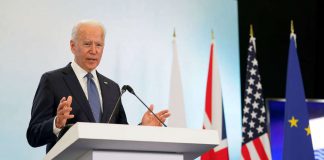JUNE 3, 2019
 Shipping containers at the Port of Melbourne in Australia. Australia was the only country to be fully exempted from the start from steel and aluminum tariffs that President Trump imposed last year.– David Crosling/EPA, via Shutterstock
Shipping containers at the Port of Melbourne in Australia. Australia was the only country to be fully exempted from the start from steel and aluminum tariffs that President Trump imposed last year.– David Crosling/EPA, via Shutterstock
WASHINGTON, D.C. — The Trump administration considered imposing tariffs on imports from Australia last week, but decided against the move amid fierce opposition from military officials and the State Department, according to several people familiar with the discussions.
Some of President Trump’s top trade advisers had urged the tariffs as a response to a surge of Australian aluminum flowing onto the American market over the past year. But officials at the Defense and State Departments told Mr. Trump the move would alienate a top ally and could come at significant cost to the United States.
The administration ultimately agreed not to take any action, at least temporarily.
The measure would open yet another front in a global trade war that has pitted the United States against allies like Canada, Mexico, Europe and Japan, and deepened divisions with countries like China. It would also be the end of a reprieve for the only country to be fully exempted from the start from steel and aluminum tariffs that Mr. Trump imposed last year.
The White House declined to comment. But the Trump administration has fiercely criticized past administrations for making concessions on trade policy to accomplish foreign policy goals. Mr. Trump has said the approach has left the United States in the position of subsidizing the world, weakening American industry and pushing factories and jobs overseas, and has pledged to rework America’s trading relationships.
But his decision to hit close allies with tariffs has also prompted an uproar. The Trump administration said it was imposing tariffs on steel and aluminum to strengthen American national security, but critics argue that the approach strains relationships with allies that are far more important to America’s defense.
The latest example came Thursday, when Mr. Trump abruptly announced that he would also levy tariffs on Mexico to try to pressure that country to stem the flow of migrants across the United States’ southern border. The move has sent foreign officials and lawmakers on Capitol Hill scrambling to head off tariffs that could damage Mexican and American businesses and threaten to derail a newly negotiated North American trade deal.
The tariffs on Australia would have hit imports of aluminum, although measures that would have applied to other products had been discussed as well. Shipments of Australian aluminum to the United States have surged since last year, when Australia became one of the few countries not to face metal tariffs.
Mr. Trump imposed a 25 percent tariff on imported steel and a 10 percent tariff on imported aluminum from many countries last year. The move was an effort to shield American producers from low-priced imports, which the administration said were a threat to the domestic industrial base and therefore national security.
Some countries, like Brazil, Argentina and South Korea, won temporary exemptions on some of their imports, but ultimately agreed to limits on how much metal they could ship to the United States. But Australia’s full exemption appears to have been the work of Prime Minister Malcolm Turnbull, who reached a handshake deal with Mr. Trump in 2017 to avoid the tariffs. In August 2018, Mr. Turnbull lost the confidence of his party and was ousted from office.
Exempting Australia from tariffs effectively allowed Australian producers to sell cheaper metals to the United States than their competitors from Europe, North America and Asia. Aluminum imports from Australia rose by 45 percent from 2017 to 2018. They are up even more, by 350 percent, for the first three months of 2019, compared with the same period in 2018.
But Australia remains a relatively small supplier of aluminum to the United States, accounting for about 6 percent of total imports so far this year, according to the United States Geological Survey.
Robert Lighthizer, the United States trade representative, and Peter Navarro, the director of the White House Office of Trade and Manufacturing Policy, were among the backers of tariffs on Australia. But other senior administration officials, who have cultivated ties to Australia, favor prioritizing other elements of the relationship.
For one thing, Australia has emerged as an important ally — perhaps the most critical one — in helping Washington constrain China’s influence in the Asia-Pacific region. Australian officials have banned the Chinese company Huawei from the country’s online networks, and have investigated the Chinese Communist Party’s influence and interference in Australia. Washington is also relying on Canberra to compete with the Chinese for political clout in the Pacific islands.
Furthermore, a conservative party won a general election last month in an upset, and Prime Minister Scott Morrison intends to enact conservative policies. That means Washington and Canberra are growing even closer, as some American officials find more affinity with their Australian counterparts.
The Australian military has over the years joined important American campaigns. Notably, Australia sent soldiers to Iraq to be part of President George W. Bush’s “coalition of the willing,” and to Afghanistan.
Tariffs against Australia could also have broader reverberations, serving as a warning to Canada and Mexico, which recently saw tariffs on steel and aluminum lifted as part of a bid to secure congressional approval of the renegotiated trade agreement with those countries that the president signed last year.
Instead of tariffs, Canada and Mexico agreed to set up a system for monitoring and enforcement for import surges into the United States. Under the agreement, the United States can reimpose tariffs on individual exports of 25 percent for steel and 10 percent for aluminum in the case of such surges.
Courtesy/Source: NY Times

































































































